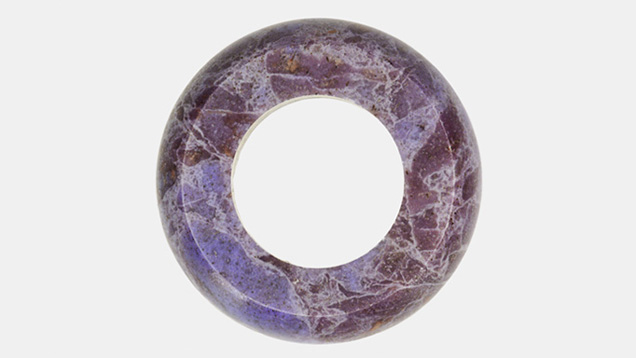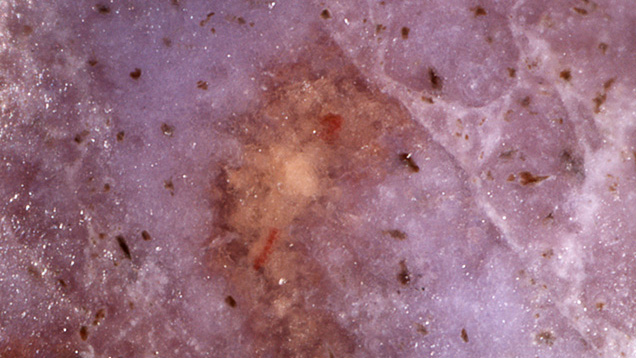Purple Jadeite Rock

Basic gemological testing was inconclusive, but Raman spectroscopy performed on the various components of the stone confirmed the lavender and white portions were a mixture of jadeite and quartz, while the reddish orange portions were cinnabar. Additional spots on the scattered needle-like inclusions matched aegerine, a sodic-ferric clinopyroxene (figure 2). In addition to Raman testing, an infrared (FTIR) spectrum was collected to confirm the stone was not polymer-impregnated (E. Fritsch et al., “Identification of bleached and polymer-impregnated jadeite,” Fall 1992 G&G, pp. 176–187; Spring 1994 Lab Notes, p. 43).

Figure 2. Upon closer examination, the jadeite rock also contains reddish orange cinnabar and brown aegerine crystals. Photomicrograph by Nathan Renfro; magnified 30×.
Purple rock containing jadeite and quartz has been reported in the Bursa region of western Turkey (M. Hatipoǧlu et al., “Gem-quality Turkish purple jade: Geological and mineralogical characteristics,” Journal of African Earth Sciences, Vol. 63, 2012, pp. 48–61). To date, the composition of this material is unique to the area. It occurs as a metamorphic product in the contact zone between a large blueschist belt and a granodiorite stock. While neither mercury nor cinnabar (a mercury sulfide) is mentioned in the literature on purple jadeite rock, mercury mining in western Turkey has been reported (M. Yildiz and E.H. Bailey, “Mercury deposits in Turkey,” U.S. Geological Survey Bulletin 1456, 1978).The presence of mercury deposits in the region makes it highly likely that cinnabar or other mercury-bearing minerals would occur in the purple jadeite rock, consistent with a Turkish origin, though the origin of this sample has not been confirmed. Because jadeite and aegerine are both sodic pyroxenes, their occurrence together is understandable.
Purplish jadeite rock is being used in the jewelry trade and fashioned into beads, cabochons, and carvings.



